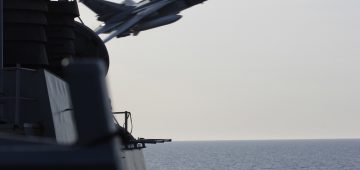AUSTRALIA REJECTS JAPANESE OPTION FOR FRENCH BOAT
A proposal from French defence giant DCNS for a conventionally-powered development of its Barracuda Class nuclear-powered attack submarine (SSN) has been selected to replace Australia’s six Collins Class patrol boats (SSKs).
Twelve Shortfin Barracuda submarines will be built by ASC in Adelaide under a deal worth Aus $43 billion, which will lead to a 50-year partnership between the two countries based on the need for continuing support and development throughout the operational life of the submarines.
The other candidates in the ferociously contested programme were a development of the Soryu Class (Japan) and Type 216 (Germany). Japan has requested clarification over the selection process, as the Soryu was the early favourite but may have suffered from a change in Australia’s national political leadership.
The French offer was selected, according to an Australian government statement, due to the ability of DCNS to best meet Australia’s requirements, including ‘superior sensor performance and stealth characteristics, as well as range and endurance similar to the Collins Class submarine,’ along with ‘cost, schedule, program execution, through-life support and Australian industry involvement’.
RUSSIA DEPLOYING MORE CRUISE MISSILE SHIPS IN THE MED
Having showcased sea-based conventional maritime strike capabilities against rebel targets in Syria during its intervention on the side of regime forces last year, Russia has decided to permanently deploy the capability aboard warships sailing in the Mediterranean.
The SS-N-30A/3M14T Kalibr-NK will be carried by an initial two Project 21631 Buyan Class corvettes from the Black Sea Fleet (BSF) which entered service in December 2015.
The previous six ships of the class serve with the Caspian Sea Fleet and were the main platforms for cruise missile strikes last October. A variant of the missile can also be fired from submarines, with the Improved Kilo Class submarines Rostov-on-Don bombarding Syrian opposition targets in both November and December.
The capabilities that Russia has showcased during its Syrian intervention have been an eye-opener for the West, which had previously dismissed Russian weaponry as outdated. It was also believed such a deployment was unsustainable as the Russian military was under-equipped and overstretched.
CHINA COMMISSIONS NEW AMPHIB VESSEL
The Peoples Liberation Army Navy (PLAN) has commissioned its fourth (Type 071) Yuzhao Class amphibious assault ship, Yimeng Shan. She is the first of the type to enter service with the East Sea Fleet as the previous three serve with the South Sea Fleet.
The East Sea Fleet is the navy’s oldest and faces Taiwan. That might lead observers to expect that it would have the best amphibious assault equipment and capacity, but equipping the South Sea Fleet appears to have been a priority due to the two marine infantry brigades it possesses.
The East Sea Fleet is perhaps now likely to have its attached marine infantry element expanded. China’s amphibious assault capabilities were previously almost entirely based on older Landing Ship Tank (LST) type vessels.
The Type 071 can land embarked troops and cargo from over the horizon using helicopters and landing craft. The three Type 071s of the South Sea Fleet have the capability to shift considerable amounts of men and material. This is, potentially, to support Beijing’s territorial claims in the South China Sea, where the PLAN has undertaken extensive amphibious exercises.

The ships have also deployed overseas in support of counter-piracy operations and visited as far as the UK. A total of eight Type 071s may ultimately be built.
It is likely at some point the Type 071s will be joined by a dedicated helicopter carrier, as Chinese shipbuilders have showcased and promoted suitable designs.
HISTORIC MISSILE TEST FOR CANADA
The modernised Halifax Class frigate HMCS Vancouver has successfully test fired a Harpoon Block II missile in so-called ‘coastal target suppression’ mode against a shore-based target. It was the first time Canada’s navy has demonstrated the capability to fire a Surface-to-Surface Missile (SSM).
It is also the first time the Harpoon Block II missile has been integrated with the combat management system fitted to the modernised Halifax Class. The test took place during Joint Littoral Training Exercise 16 (JoLTEX16) at a US Navy firing range off the Californian coast. The successful missile test means Canada’s navy now possess an enhanced capability to strike from sea to shore.
It is the result of a US $4.3 billion programme to modernise and overhaul the Halifax frigates and their weaponry. The upgrade programme means they will be able to serve into the 2030s. Meanwhile, Canada is also to trial a programme aimed at advancing novel naval concepts in warship deployment, crewing and sustainment.
This will happen aboard the Halifax Class frigate Montreal.
Called the X-Ship programme, it will last for five years. Experiments will be carried out, focusing on aspects including how crew size variations affect rest and performance, plus other operational trials. Operational and technical aspects such as environmental effects on the ship, information systems trials and structural health monitoring will also be closely scrutinised.
LITTORAL MISSION VESSEL PROGRESS
Singapore’s Littoral Mission Vessel (LMV) programme continues apace, with the completion of sea acceptance trials for the first and launch of the second.
Independence has completed her sea acceptance trials with the second ship of eight proposed now named Sovereignty.
Singapore’s ST Marine and Sweden’s Saab Kockums AB have jointly designed the LMV, as part of a continuing effort to improve Singapore’s maritime security.
The small Asian state relies almost entirely on free movement of sea trade for its wealth.
For more naval news and the full versions of some of these news-in-brief, buy WARSHIPS IFR magazine.







Comments
Sorry, comments are closed for this item